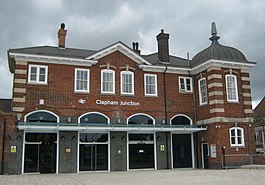Clapham Junction railway station
| Clapham Junction | |
|---|---|
 South West (Brighton Yard) entrance | |
 Clapham Junction Location of Clapham Junction in Greater London | |
| Location | Battersea |
| Local authority | London Borough of Wandsworth |
| Managed by | Network Rail |
| Station code | CLJ |
| DfT category | B |
| Number of platforms | 17 |
| Accessible | Yes[1] |
| Fare zone | 2 |
| Cycle parking | Yes – external |
| Toilet facilities | Yes – behind gateline |
| National Rail annual entry and exit | |
| 2015–16 | |
| – interchange | |
| 2016–17 | |
| – interchange | |
| 2017–18 | |
| – interchange | |
| 2018–19 | |
| – interchange | |
| 2019–20 | |
| – interchange | |
| Key dates | |
| 2 March 1863 | Opened |
| Other information | |
| External links | |
| WGS84 | 51°27′53″N 0°10′14″W / 51.4646°N 0.1705°WCoordinates: 51°27′53″N 0°10′14″W / 51.4646°N 0.1705°W |
Clapham Junction railway station (/ˈklæpəmˈdʒʌŋkʃən/[3]) is a major railway station and transport hub near St John's Hill in south-west Battersea in the London Borough of Wandsworth. It is 2 miles 57 chains (2.71 mi; 4.37 km) from London Victoria and 3 miles 74 chains (3.93 mi; 6.32 km) from London Waterloo;[4] it is on both the South West Main Line and Brighton Main Line as well as numerous other routes and branch lines passing through or diverging from the main lines at this station. Despite its name, Clapham Junction is not located in Clapham, a district situated approximately 1 mile (1.6 km) to the south-east.
Routes from London's south and south-west termini, Victoria and Waterloo, funnel through the station, making it the busiest in Europe[5][better source needed] by number of trains using it: between 100 and 180 per hour except for the five hours after midnight. The station is also the busiest UK station for interchanges between services,[6] and the only railway station in Great Britain with more interchanges than entries or exits.[7]
| show London Overground |
|---|
